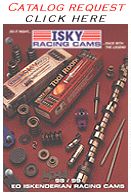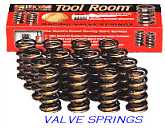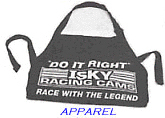|
|
 |
|
||
|
Because the motor octane test is far more demanding, the results are considered far more relevant. Look for the motor octane numbers for a more accurate comparison. Your particular racing application may require a specific octane requirement. While very high-octane fuel provides extra detonation protection, in some cases, it may impede power. As an example, NHRA drag racer David Rampy may use VP C25, which has a 113 motor octane number, in his Competition Eliminator entry but uses VP C15, which has a 115 motor octane number, in his Super Comp dragster. The goal in Comp is more horsepower. The motor can be on the "edge" because it's routinely torn down for inspection. With the Super Comp motor, reliability is a high priority because hundreds of runs are intended between rebuilds. As a general rule, your motor's compression ratio will determine the octane level of the fuel you will need. Here is a basic guideline for the average bracket drag racing motor: 97 mon, up to 11.0 to 1 compression 105 mon, up to 12.5 to 1 compression 108 mon, up to 14.0 to 1 compression VP currently has over 40 different blends of fuel available for the many different types of motorsports. With each application, all of the specifics are taken into consideration. Along with the compression ratio, its important to know the RPM range, cubic inches, is it turbocharged, supercharged, or is nitrous being used, and how much nitrous? What type of cylinder head is being used? All of these factors are important. If you take your racing serious, look what the winners in your class may be using for fuel, and call the manufacturer for a recommendation on your application. For you racers that are looking to save a buck, please resist the temptation to buy Aviation fuel. Av-gas, is designed to be used in airplanes, at high altitudes, with the engine operating at between 2800 to 3200 RPM. It is very light in specific gravity and is low in lead content. It's really not suitable for any bracket motor and definitely not for serious race motors. That brings us to the availability of the fuel you need at the time you need it. Just recently, one of my dealers got a call from a racer who had rented a racetrack here in Florida for testing. After arriving at the track, he discovered that the track's fuel station wasn't open during private test days and it didn't carry the fuel he needed anyway. He frantically called looking for fuel and, fortunately, our dealer in that area had the fuel he wanted. This type of story is repeated far too many times during the racing season. Most racetracks will only have two or three of the most popular types of fuel for general applications available at their pumps. Also, various racetracks have contracts with their fuel suppliers that limit other brands of fuel from being sold at their facility. Don't be a bonehead! Arriving at the track hoping someone else anticipated your fuel need is foolish. Consider purchasing your fuel ahead of time or make arrangements to have it available in the area that you are traveling to. Fuel is available in drum sizes of 54, 30, and 15 gallons and 5 gallon sealed cans. Keep unused fuel in a sealed drum. If a fuel jug is used, a dark color jug is best, and make sure it seals up tight also. If you are coming to Florida for one of the many races here during the winter months, feel free to call our office to make arrangements for your fuel needs. We have dealers close to all the major racing facilities here, and one of them will help you get the fuel you need when you need it. Sources: VP Racing Fuel Headquarters |
||||

Copyright 1999-2002, Drag Racing Online and Racing Net Source |
||||










